The customer marketing journey in SaaS is like rock climbing minus the risk of potential death. But you’re falling, dodging, climbing, and hoping to scale the top of a mountain.
Jason Lemkin, CEO and Founder of SaaStr, said, “How much do you talk about Customer Marketing? Be honest. It’s the #1 thing SaaS companies do the least of, that they should be doing far more of. It’s often an afterthought in the chase for new names, new leads, and new logos.”
Tara Robertson, CMO at Bitly, says there is no playbook for customer marketing. Many people believe marketing equals generating demand, but Robertson doesn’t think so.
Marketing is about generating value, and when you create value for a person on the other side of the funnel, you create demand.
Keep reading to learn Robertson’s five customer marketing strategies guaranteed to grow your business.
Know Your Customers
You should always start with customer research, no matter what type of business you’re running.
Why?
With customer research, you can see a 10x increase year-over-year in annual company revenue, customer satisfaction, and a 20% increase in upsell and cross-sell rates.
But get this?
65% of marketers aren’t doing it because it’s a pain, it’s hard, and people don’t see it as necessary.
If you aren’t doing customer research, you’re missing a 10x opportunity.
How do you conduct customer research?
You want to know what people think, feel, and do at each stage of your funnel. From there, you want to identify 3-5 low-hanging fruit and prioritize campaigns based on how they feel during those opportunities.
This is how you start creating your customer journey roadmap.
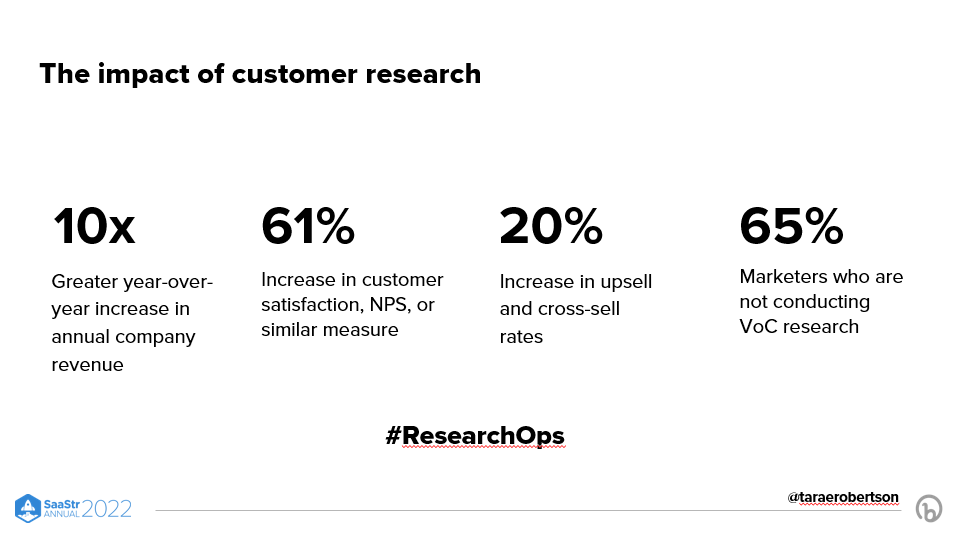
How do you know it’s all working?
There are plenty of ways to bring qualitative insights.
For companies that already have customers, you can conduct interviews and surveys. Always keep questions open-ended. You don’t want to give people answers. You want them to give answers to you.
Some VoC survey questions you might ask are:
- What was going on in your life that caused you to start looking for a solution?
- Once you realized you had a problem, what did you do next?
- Before you signed up, did you imagine what life would be like? What were you expecting?
- Now that you are working with XYZ, what’s the number one thing you can do that you weren’t before?
- If you had a magic wand and could change anything in our software, what would it be?
For those organizations who don’t already have a solid customer base to pull from, you can utilize social listening and mining data on review sites like G2 to start to understand competitors and why customers are going to them.
The Takeaway —
Great customer knowledge is just as important as great product knowledge. Spend as much time getting to know customers as you do getting to know your product.
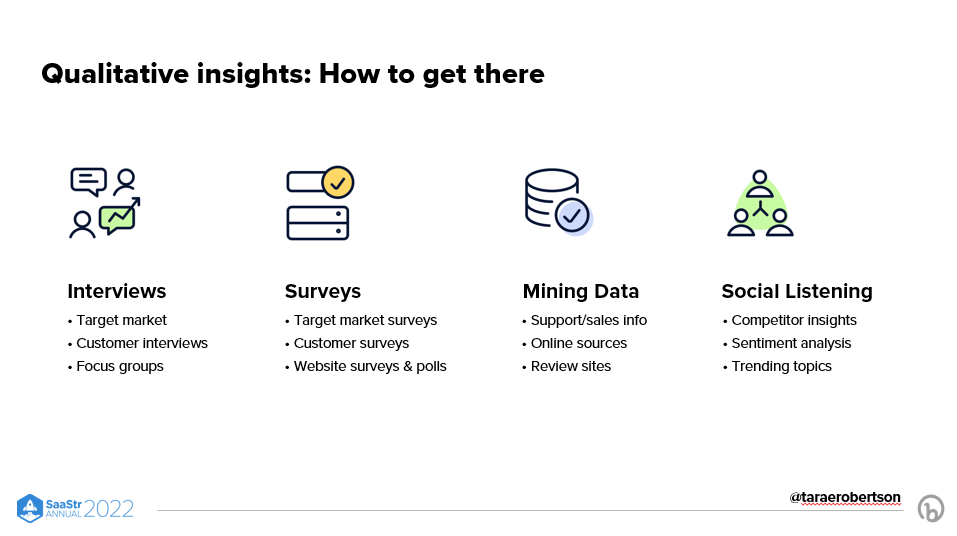
Scale Intentionally and Make Trade-Offs
As you grow your org, you may ask yourself, “What am I looking for? Who am I hiring? What does the team need to look like?”
The answer? It depends on the problems you’re trying to solve and the results you hope to achieve.
Where do you focus?
There are a million places you can focus, but if you chase two rabbits, you’ll likely lose both of them.
When building a team, start where you’re experiencing the most drop-off in your funnel.
How do you measure success?
At Sprout Social, Robertson brought the Rule of 3 to the customer roadmap. “Productivity is only productivity when focused on the right things,” she says.
The three most important areas of focus almost always include:
- Great onboarding
- Content to educate customers
- Campaigns as a foundation
The Takeaway —
Invest in your team and prioritize ruthlessly.
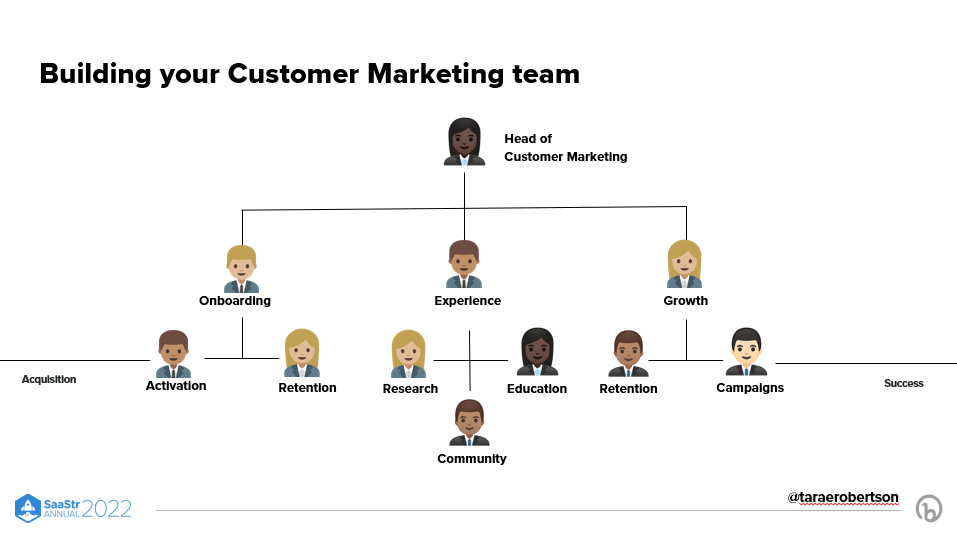
Build Strong Segmentation
Our expectations as consumers have changed over the last few years. The amount of information a person receives daily is insane.
How do you manage the amount of communication going to your customers?
The goal is to map where each team is coming from and audit the number of times you contact customers and why each team is reaching out to them in the first place.
There are three popular segmentation approaches:
- JTBD (Jobs To Be Done) — Typically product-led. People don’t just buy products but hire you to solve a specific problem.
- Persona — Much more marketing-led, typically focused on the unique attributes of a specific person and what makes them want to buy.
- ICP (Ideal Customer Profile) — Tends to be a segmentation approach used for account-based marketing and company attributes.
You might use all three simultaneously for different reasons, so you’ll use your customer research to determine how to segment customers.
The Takeaway —
Segmentation is critical to building communications that convert.
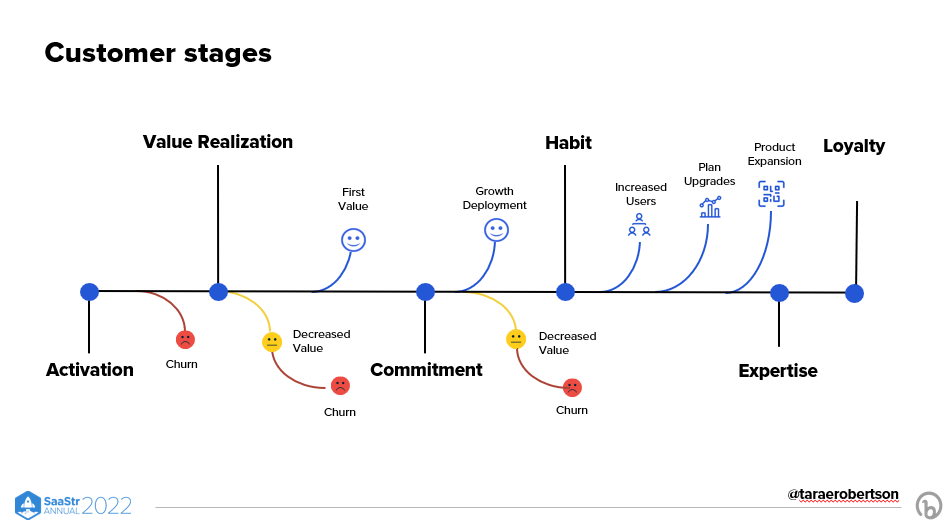
Educate Your Customers
Who gets frustrated when someone churns from your product because they think it doesn’t do something that it actually can do?
Only 61% of a product is actually used across all tech. That’s why education is so important.
But education and building out learning centers take a lot of work, you say?
Get scrappy.
Start with a webinar on a landing page and send it out in an email. It doesn’t need to be fancy. You just have to start.
A small step can help people engage with your content, and they become stickier.
Try one or some of these four common educational paths.
- Live training — Webinars are easiest from a marketing perspective, and you can glean great customer research.
- Content — A huge part of building out customer education is self-guided and customer-led content.
- Product tours — Have your product team lead product tours.
- Community — This can be marketing or customer-led.
“Great education equals exceptional growth,” says Robertson.
The Takeaway —
Your customers are not using your product to its potential. It’s your job to help them do so through education.
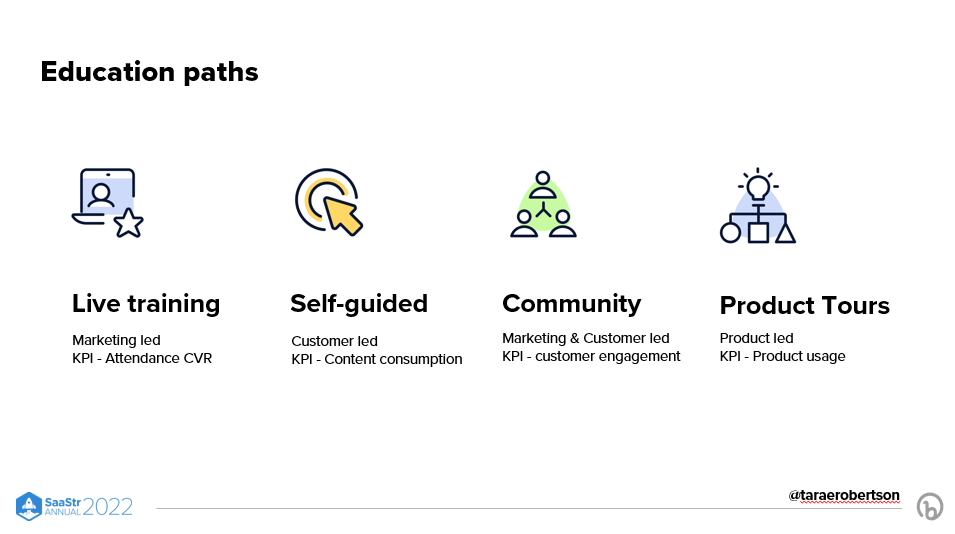
Treat Every Customer As a VIP
You aren’t marketing to a business when marketing and building out programs. You’re marketing to people, and people want to connect.
Start with the idea of having one customer. All of your other customers went away. How would you interact with them? That’s how you want to think about scaling 1:many.
Create surprise and delight that people will remember. A handwritten thank you note or letter in the mail has a 300% better open rate than one that isn’t handwritten.
If you don’t think this type of connection with customers is scalable, it is.
Don’t underestimate a personalized response through email, either. People receive so much mail in their inboxes and mailbox, so a personal gesture goes a long way toward making a person feel important.
The Takeaway —
People thrive on personal, meaningful connections.
Key Takeaways
Your five steps to customer marketing growth include the following:
- Know Your Customer — Start with research to intentionally build a roadmap.
- Scale Intentionally — Make sure you build your team based on data and prove results based on data.
- Segmentation Is Key — Ensure communications are focused on the people you’re reaching out to.
- Invest In Education — Make sure you’re educating customers, and it starts with one simple webinar.
- Treat every customer as an important person.

